Simultaneous Improvement of Strength, Ductility and Damping Capacity of Single β-Phase Mg–Li–Al–Zn Alloys
Abstract
1. Introduction
2. Methods
3. Result and Discussion
3.1. Microstructures and Hardness
3.2. Mechanical Properties
3.3. Damping Properties
4. Conclusions
- (1)
- Both as-cast LAZ1333 alloy and LAZ1366 alloy are composed of β-Li phase and AlLi phase. After the solid solution treatment, the AlLi phase is dissolved, but the hot rolling and subsequent aging make the AlLi phase re-precipitate and disperse in the matrix;
- (2)
- The as-aged LAZ1333 alloy has the best mechanical properties, and its UTS and FE are 184 MPa and 32%, respectively. The UTS and FE of as-aged LAZ1333 alloy increased by 65.8% and 89.3% higher than that of the as-cast alloy. It can be mainly attributed to the combined effect of grain refinement strengthening, dislocations strengthening and dispersion strengthening;
- (3)
- The reason why the UTS and FE of the as-aged LAZ1366 alloy cannot be greatly improved is mainly due to the excess precipitation of AlLi softening phase and the solid solution of excess Zn element;
- (4)
- The as-aged state of LAZ1333 and LAZ1366 alloys exhibits higher damping capacity than as-cast state, and their damping value in the low-strain amplitude stage is larger than 0.014. The improvement in damping capacity is mainly attributed to the increase in the distance of dislocation movement due to the decrease in the number of solute atoms in the matrix.
Author Contributions
Funding
Data Availability Statement
Conflicts of Interest
References
- Wang, J.; Du, C.; Wu, R.; Xu, L.; Feng, J.; Zhang, J.; Hou, L.; Liu, M.; Liu, B. Effect of Li content on electromagnetic shielding effectiveness in binary Mg–Li alloys: A combined experimental and first-principles study. J. Mater. Sci. Mater. Electron. 2022, 33, 3891–3900. [Google Scholar] [CrossRef]
- Wang, J.; Xu, L.; Wu, R.; Feng, J.; Zhang, J.; Hou, L.; Zhang, M. Enhanced electromagnetic interference shielding in a duplex-phase Mg–9Li–3Al–1Zn alloy processed by accumulative roll bonding. Acta Metall. Sin. (Engl. Lett.) 2020, 33, 490–499. [Google Scholar] [CrossRef]
- Hou, P.; Li, F.; Wu, R.; Gao, R.; Zhang, A. Annealing coordinates the deformation of shear band to improve the microstructure difference and simultaneously promote the strength-plasticity of composite plate. Mater. Des. 2022, 219, 110696. [Google Scholar]
- Ren, L.; Quan, G.; Xu, Y.; Yin, D.; Lu, J.; Dang, J. Effect of heat treatment and predeformation on damping capacity of cast Mg–Y binary alloys. J. Alloys Compd. 2017, 699, 976–982. [Google Scholar] [CrossRef]
- Ma, X.; Jin, S.; Wu, R.; Wang, J.; Wang, G.; Krit, B.; Betsofen, S. Corrosion behavior of Mg–Li alloys: A review. Trans. Nonferrous Met. Soc. China 2021, 31, 3228–3254. [Google Scholar] [CrossRef]
- Yan, H.; Zhou, X.; Gao, X.; Chen, J.; Xia, W.; Su, B.; Song, M. Development of the finegrained Mg–0.6Zr sheets with enhanced damping capacity by high strain rate rolling. Mater. Charact. 2021, 172, 110826. [Google Scholar] [CrossRef]
- Wang, J.; Sun, D.; Wu, R.; Du, C.; Yang, Z.; Zhang, J.; Hou, L. A good balance between mechanical properties and electromagnetic shielding effectiveness in Mg–9Li–3Al–1Zn alloy. Mater. Charact. 2022, 188, 111888. [Google Scholar] [CrossRef]
- Dobkowska, A.; Adamczyk, B.; Kuc, D.; Hadasik, E.; Płociński, T.; Bińczyk, E.; Mizera, J. Influence of bimodal grain size distribution on the corrosion resistance of Mg–4Li–3Al–1Zn (LAZ431). J. Mater. Res. Technol. 2021, 13, 346–358. [Google Scholar] [CrossRef]
- Dobkowska, A.; Adamczyk, B.; Towarek, A.; Maj, P.; Bińczyk, E.; Momeni, M.; Kuc, D.; Hadasik, E.; Mizera, J. The influence of microstructure on corrosion resistance of Mg–3Al–1Zn–15Li (LAZ1531) alloy. J. Mater. Eng. Perform. 2020, 29, 2679–2686. [Google Scholar] [CrossRef]
- Ji, H.; Peng, X.; Zhang, X.; Liu, W.; Wu, G.; Zhang, L.; Ding, W. Balance of mechanical properties of Mg–8Li–3Al–2Zn–0.5Y alloy by solution and low-temperature aging treatment. J. Alloys Compd. 2019, 791, 655–664. [Google Scholar] [CrossRef]
- Sun, Y.; Wang, R.; Peng, C.; Wang, X. Microstructure and corrosion behavior of as-homogenized Mg–xLi–3Al–2Zn0.2Zr alloys (x = 5, 8, 11 wt%). Mater. Charact. 2020, 159, 110031. [Google Scholar] [CrossRef]
- Peng, X.; Liu, W.; Wu, G.; Ji, H.; Ding, W. Plastic deformation and heat treatment of Mg–Li alloys: A review. J. Mater. Sci. Technol. 2022, 99, 193–206. [Google Scholar] [CrossRef]
- Ji, Q.; Wang, Y.; Wu, R.; Wei, Z.; Ma, X.; Zhang, J.; Hou, L.; Zhang, M. High specific strength Mg–Li–Zn–Er alloy processed by multi deformation processes. Mater. Charact. 2020, 160, 110135. [Google Scholar] [CrossRef]
- Sun, Y.; Wang, R.; Ren, J.; Peng, C.; Feng, Y. Hot deformation behavior of Mg–8Li–3Al–2Zn–0.2Zr alloy based on constitutive analysis, dynamic recrystallization kinetics, and processing map. Mech. Mater. 2019, 131, 158–168. [Google Scholar] [CrossRef]
- Liang, X.; Peng, X.; Ji, H.; Liu, W.; Wu, G.; Ding, W. Microstructure and mechanical properties of as-cast and solid solution treated Mg–8Li–xAl–yZn alloys. Trans. Nonferrous Met. Soc. China 2021, 31, 925–938. [Google Scholar] [CrossRef]
- Tang, S.; Xin, T.; Xu, W.; Miskovic, D.; Sha, G.; Quadir, Z.; Ringer, S.; Nomoto, K.; Birbilis, N.; Ferry, M. Precipitation strengthening in an ultralight magnesium alloy. Nat. Commun. 2019, 10, 1003. [Google Scholar] [CrossRef] [PubMed]
- Jin, S.; Ma, X.; Wu, R.; Li, T.; Wang, J.; Krit, B.; Hou, L.; Zhang, J.; Wang, G. Effect of carbonate additive on the microstructure and corrosion resistance of plasma electrolytic oxidation coating on Mg–9Li–3Al alloy. Int. J. Miner. Metall. Mater. 2022, 29, 1453–1463. [Google Scholar] [CrossRef]
- Wang, J.; Wu, R.; Feng, J.; Zhang, J.; Hou, L.; Liu, M. Recent advances of electromagnetic interference shielding Mg matrix materials and their processings: A review. Trans. Nonferrous Met. Soc. China 2022, 32, 1385–1404. [Google Scholar] [CrossRef]
- Zhang, D.; Shi, G.; Zhao, X.; Qi, F. Microstructure evolution and mechanical properties of Mg–x%Zn–1%Mn (x = 4, 5, 6, 7, 8, 9) wrought magnesium alloys. Trans. Nonferrous Met. Soc. China 2011, 21, 15–25. [Google Scholar] [CrossRef]
- Mirzadeh, H. A comparative study on the hot flow stress of Mg–Al–Zn magnesium alloys using a simple physically-based approach. J. Magnes. Alloy. 2014, 2, 225–229. [Google Scholar] [CrossRef]
- Wang, J.; Xu, L.; Wu, R.; An, D.; Wei, Z.; Wang, J.; Feng, J.; Zhang, J.; Hou, L.; Liu, M. Simultaneous achievement of high electromagnetic shielding effectiveness (X-band) and strength in Mg–Li–Zn–Gd/MWCNTs composite. J. Alloys Compd. 2021, 882, 160524. [Google Scholar] [CrossRef]
- Li, W.; Deng, K.; Zhang, X.; Nie, K.; Xu, F. Effect of ultra-slow extrusion speed on the microstructure and mechanical properties of Mg–4Zn–0.5Ca alloy. Mater. Sci. Eng. A Struct. 2016, 677, 367–375. [Google Scholar] [CrossRef]
- Wang, C.; Kang, J.; Deng, K.; Nie, K.; Liang, W.; Li, W. Microstructure and mechanical properties of Mg–4Zn–xGd (x = 0, 0.5, 1, 2) alloys. J. Magnes. Alloy 2020, 8, 441–451. [Google Scholar] [CrossRef]
- Liu, W.; Zeng, Z.; Hou, H.; Zhang, J.; Zhu, Y. Dynamic precipitation behavior and mechanical properties of hot-extruded Mg89Y4Zn2Li5 alloys with different extrusion ratio and speed. Mater. Sci. Eng. A 2020, 798, 140121. [Google Scholar] [CrossRef]
- Tang, S.; Xin, T.; Luo, T.; Ji, F.; Li, C.; Feng, T.; Lan, S. Grain boundary decohesion in body-centered cubic Mg–Li–Al alloys. J. Alloys Compd. 2022, 902, 163732. [Google Scholar] [CrossRef]
- Wang, J.; Jin, Y.; Wu, R.; Wang, D.; Qian, B.; Zhang, J.; Hou, L. Simultaneous improvement of strength and damping capacities of Mg–8Li–6Y–2Zn alloy by heat treatment and hot rolling. J. Alloys Compd. 2022, 927, 167027. [Google Scholar] [CrossRef]
- Wang, D.; Liu, S.; Wu, R.; Zhang, S.; Wang, Y.; Wu, H.; Zhang, J.; Hou, L. Synergistically improved damping, elastic modulus and mechanical properties of rolled Mg–8Li–4Y–2Er–2Zn–0.6Zr alloy with twins and long-period stacking ordered phase. J. Alloys Compd. 2021, 881, 160663. [Google Scholar] [CrossRef]
- Wang, D.; Wu, H.; Wu, R.; Wang, Y.; Zhang, J.; Betsofen, S.; Krit, B.; Hou, L.; Nodir, T. The transformation of LPSO type in Mg–4Y–2Er–2Zn–0.6Zr and its response to the mechanical properties and damping capacities. J. Magnes. Alloy. 2020, 8, 793–798. [Google Scholar] [CrossRef]
- Qian, B.Y.; Wu, R.Z.; Sun, J.F.; Zhang, J.H.; Hou, L.G.; Ma, X.C.; Wang, J.H.; Hu, H.T. Evolutions of Microstructure and Mechanical Properties in Mg–5Li–1Zn–0.5Ag–0.5Zr–xGd Alloy. Acta Metall. Sin. (Engl. Lett.) 2023. [Google Scholar] [CrossRef]
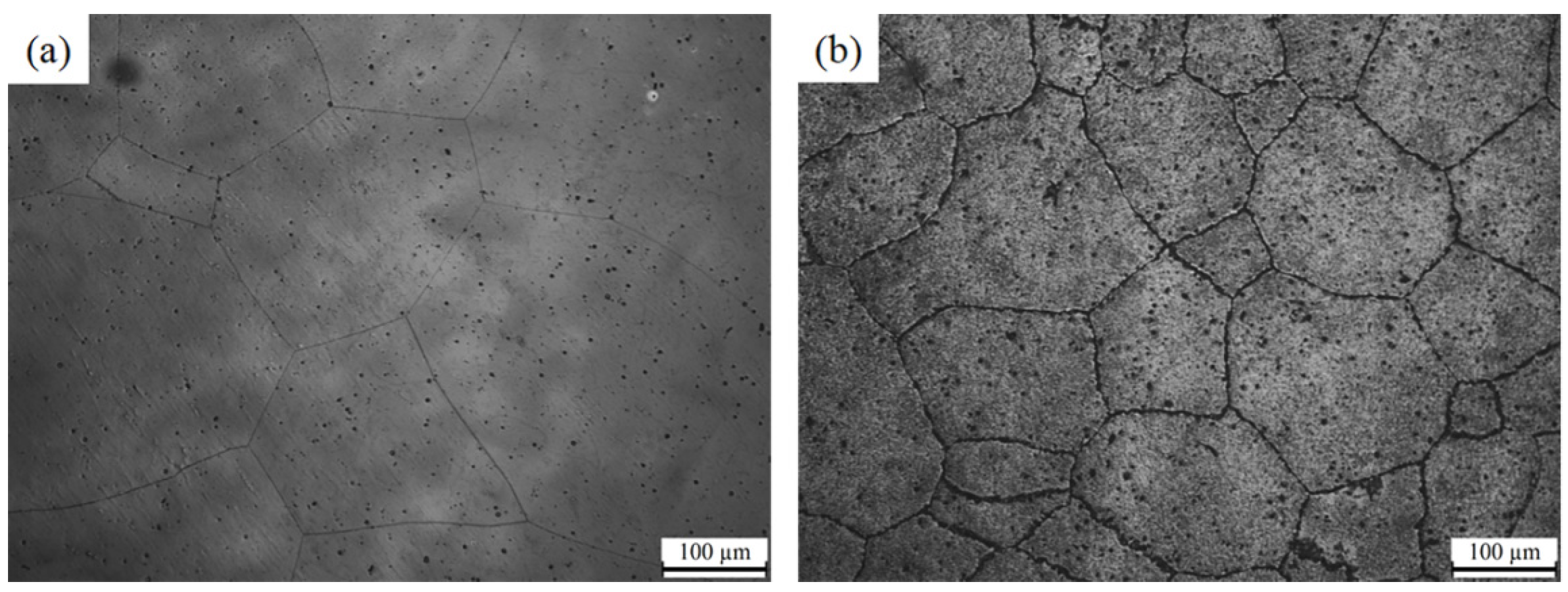
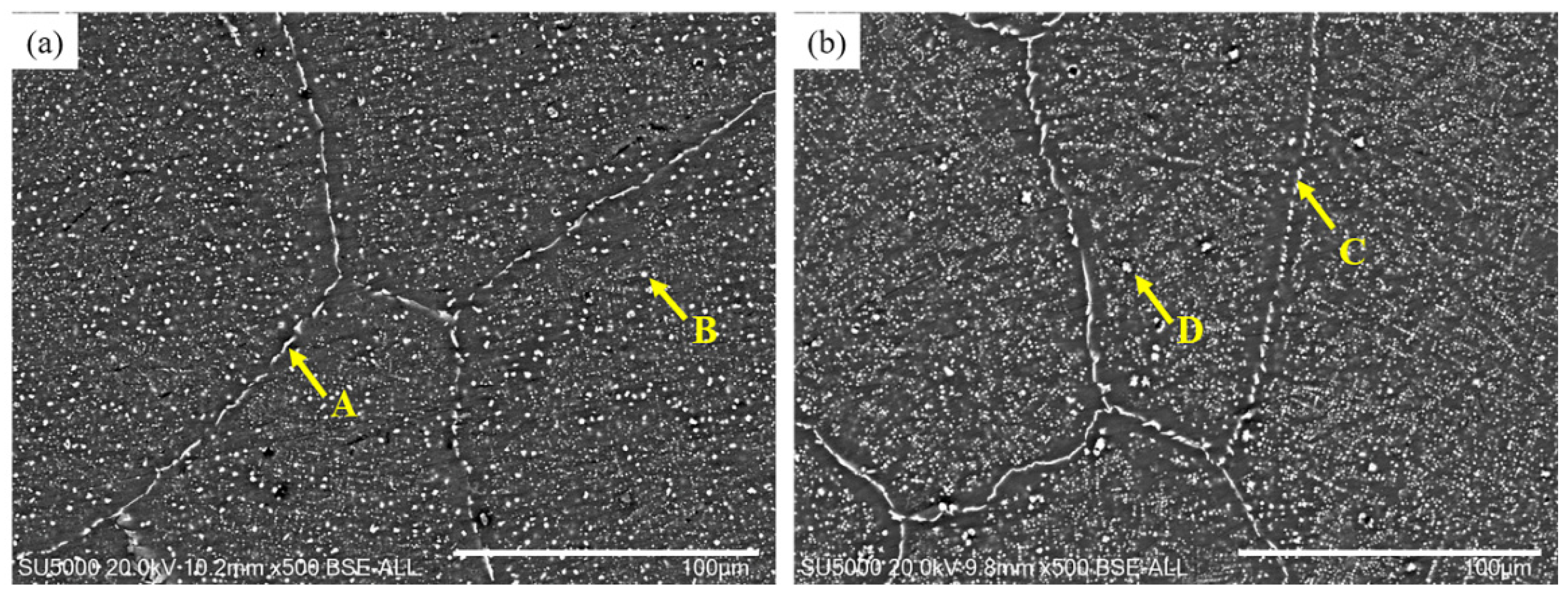

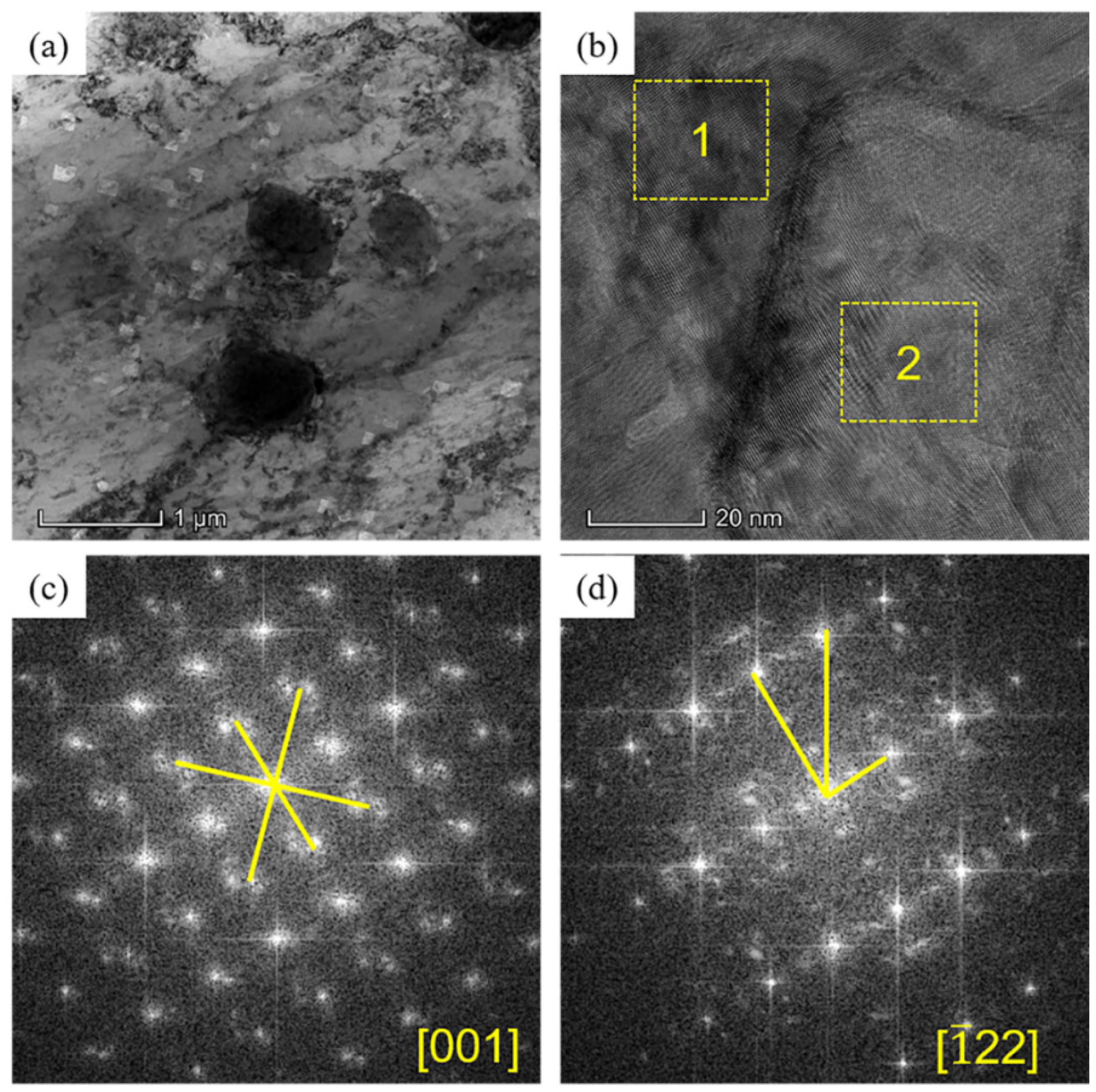
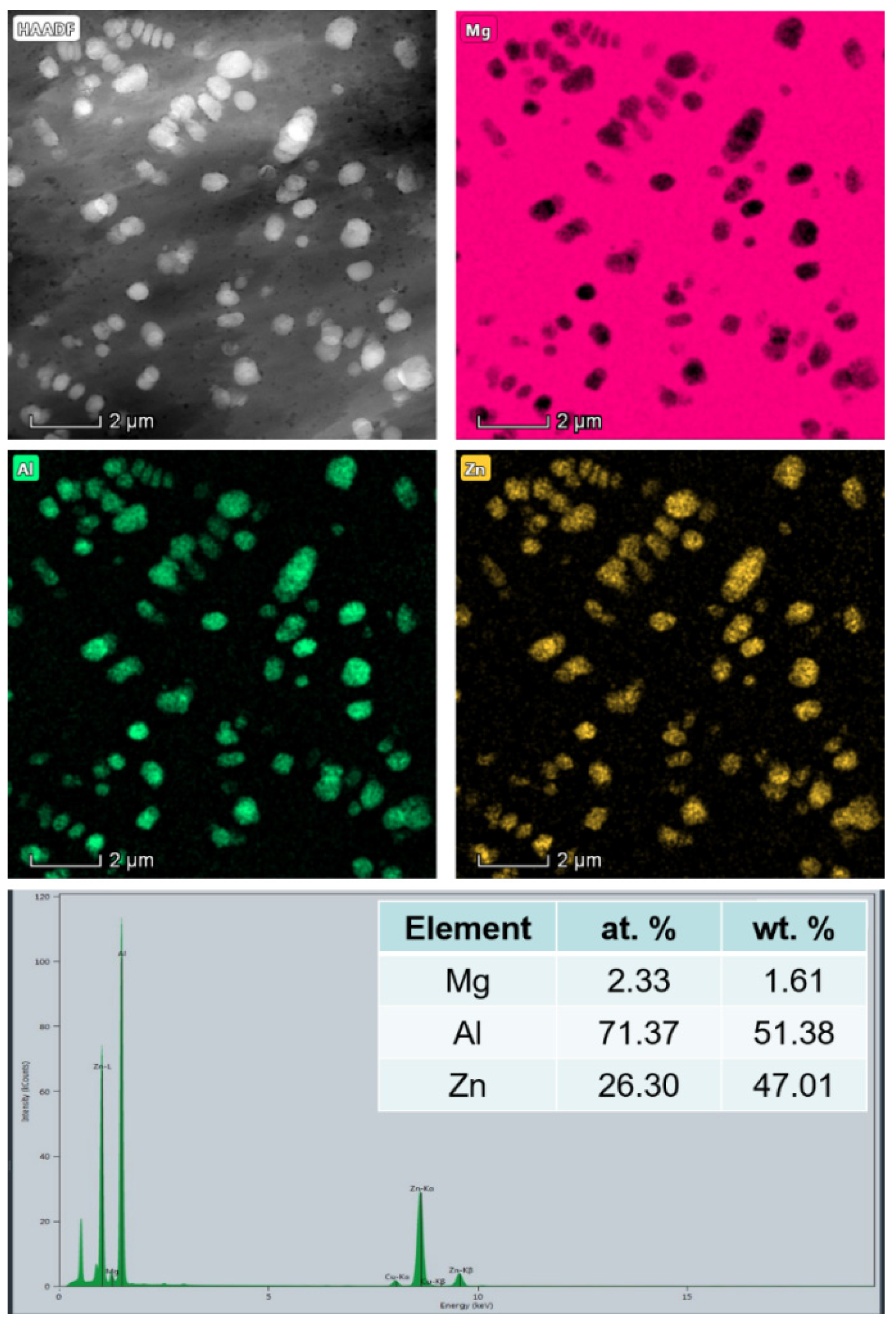


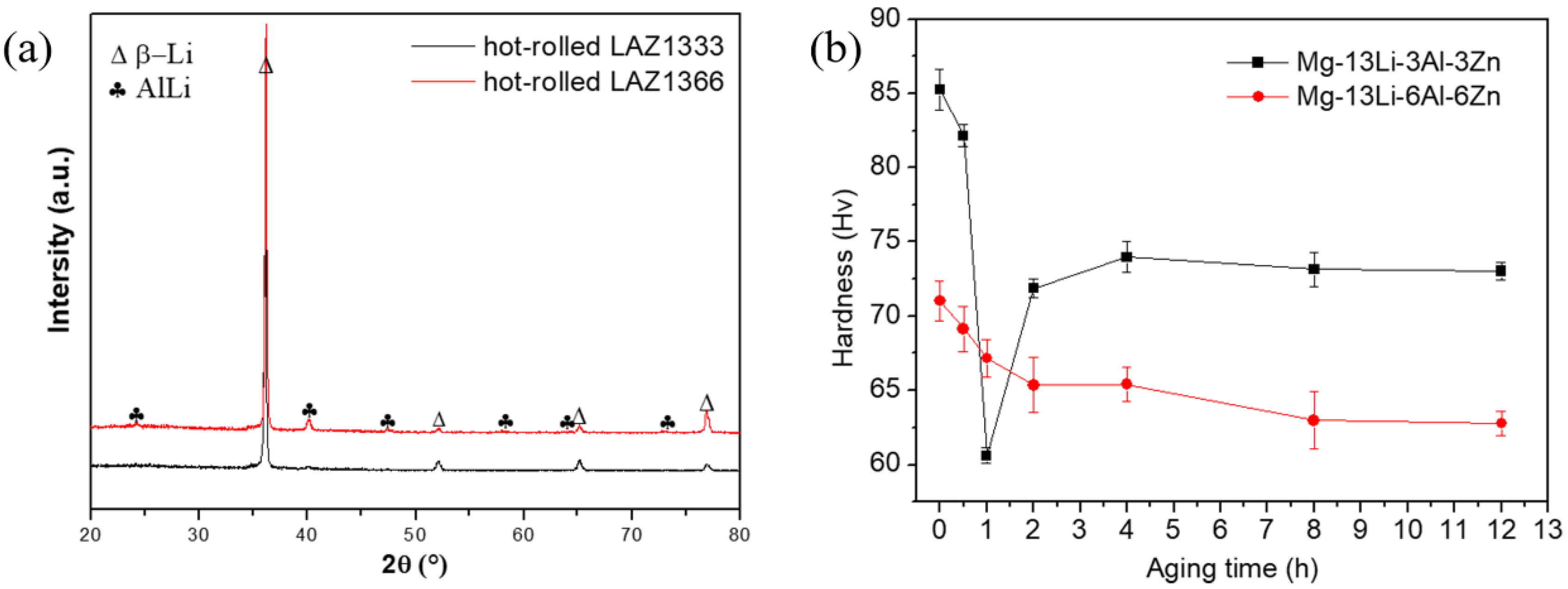


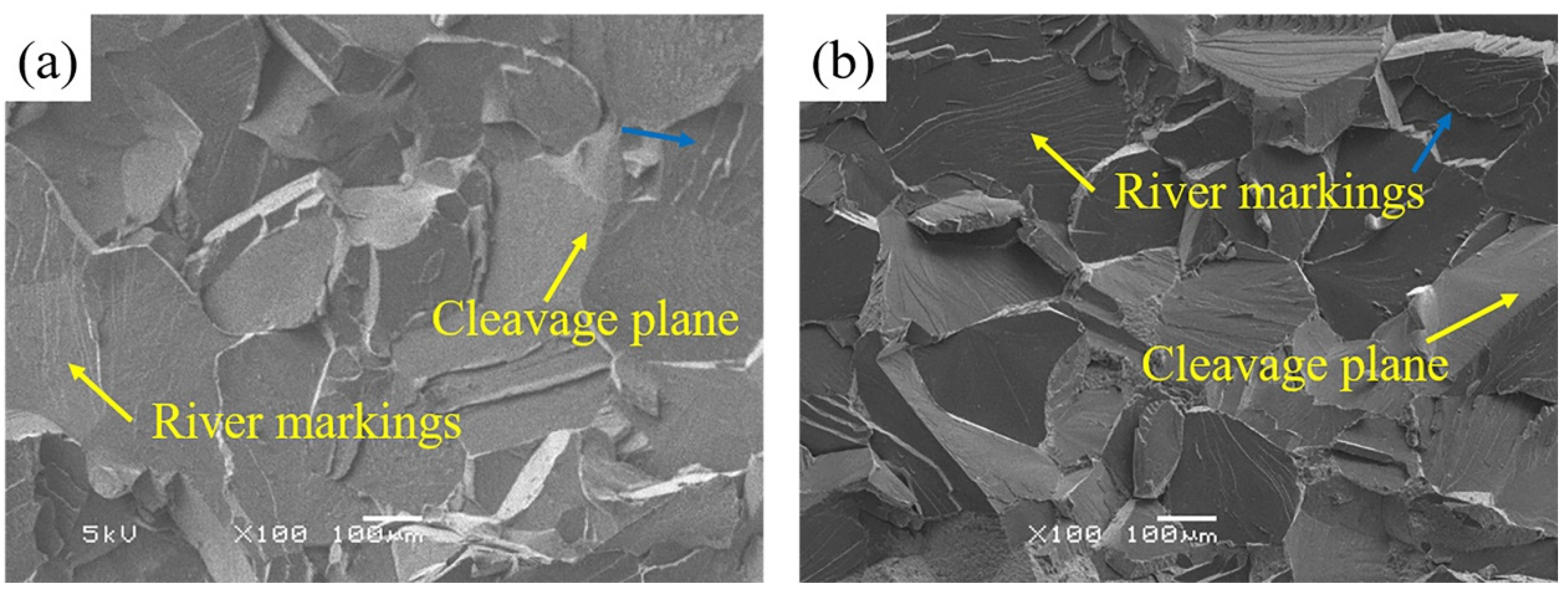



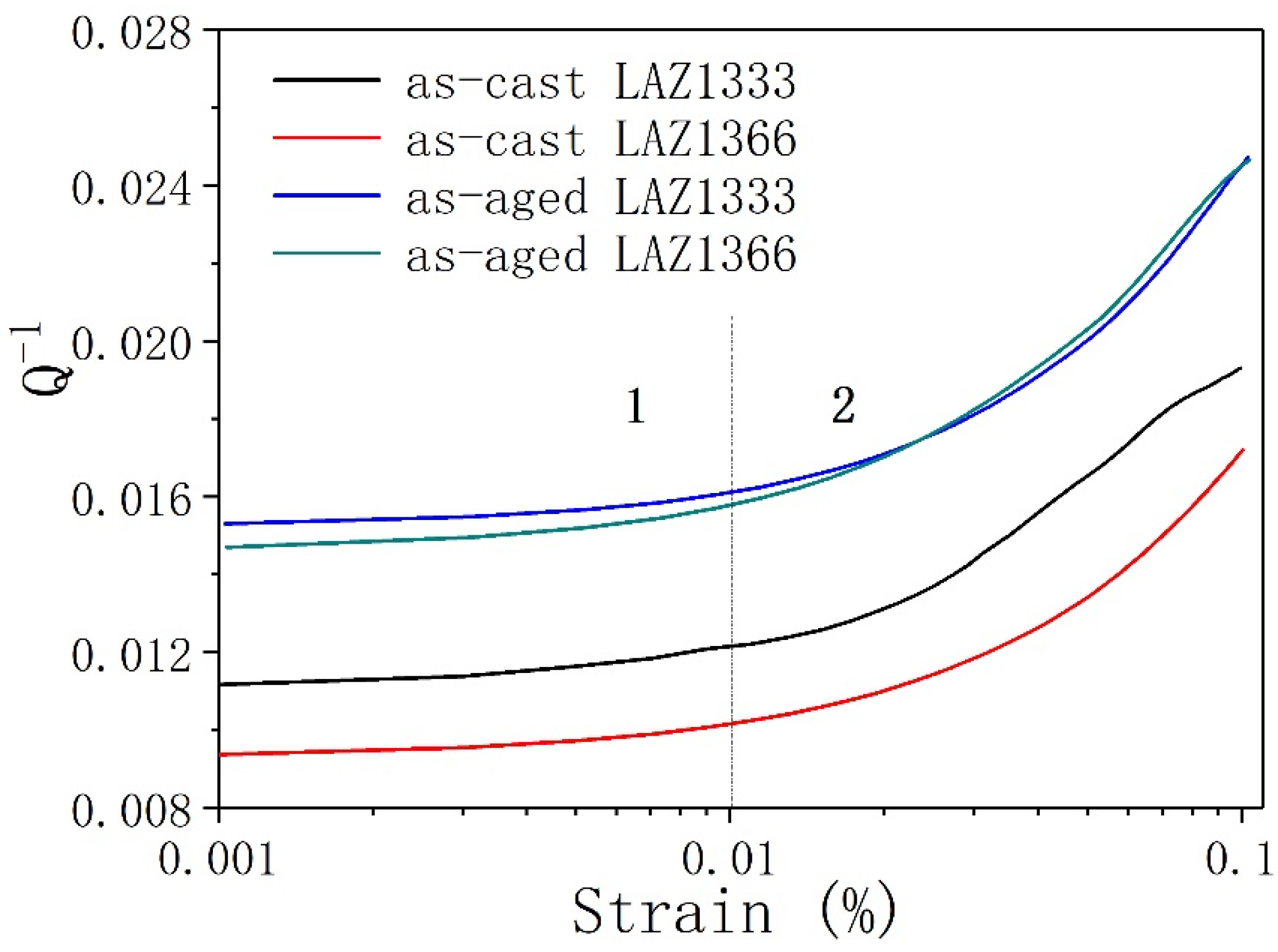
| Positions | Chemical Compositions (at%) | ||
|---|---|---|---|
| Mg | Al | Zn | |
| A | 87.03 | 9.10 | 3.87 |
| B | 87.20 | 9.44 | 3.36 |
| C | 90.43 | 6.79 | 2.78 |
| D | 93.36 | 4.50 | 2.14 |
| Positions | Chemical Compositions (at%) | ||
|---|---|---|---|
| Mg | Al | Zn | |
| A | 72.24 | 25.94 | 1.82 |
| B | 54.08 | 43.95 | 1.97 |
Disclaimer/Publisher’s Note: The statements, opinions and data contained in all publications are solely those of the individual author(s) and contributor(s) and not of MDPI and/or the editor(s). MDPI and/or the editor(s) disclaim responsibility for any injury to people or property resulting from any ideas, methods, instructions or products referred to in the content. |
© 2023 by the authors. Licensee MDPI, Basel, Switzerland. This article is an open access article distributed under the terms and conditions of the Creative Commons Attribution (CC BY) license (https://creativecommons.org/licenses/by/4.0/).
Share and Cite
Yang, X.; Jin, Y.; Wu, R.; Wang, J.; Wang, D.; Ma, X.; Hou, L.; Serebryany, V.; Tashlykova-Bushkevich, I.I.; Betsofen, S.Y. Simultaneous Improvement of Strength, Ductility and Damping Capacity of Single β-Phase Mg–Li–Al–Zn Alloys. Metals 2023, 13, 159. https://doi.org/10.3390/met13010159
Yang X, Jin Y, Wu R, Wang J, Wang D, Ma X, Hou L, Serebryany V, Tashlykova-Bushkevich II, Betsofen SY. Simultaneous Improvement of Strength, Ductility and Damping Capacity of Single β-Phase Mg–Li–Al–Zn Alloys. Metals. 2023; 13(1):159. https://doi.org/10.3390/met13010159
Chicago/Turabian StyleYang, Xinhe, Yang Jin, Ruizhi Wu, Jiahao Wang, Dan Wang, Xiaochun Ma, Legan Hou, Vladimir Serebryany, Iya I. Tashlykova-Bushkevich, and Sergey Ya. Betsofen. 2023. "Simultaneous Improvement of Strength, Ductility and Damping Capacity of Single β-Phase Mg–Li–Al–Zn Alloys" Metals 13, no. 1: 159. https://doi.org/10.3390/met13010159
APA StyleYang, X., Jin, Y., Wu, R., Wang, J., Wang, D., Ma, X., Hou, L., Serebryany, V., Tashlykova-Bushkevich, I. I., & Betsofen, S. Y. (2023). Simultaneous Improvement of Strength, Ductility and Damping Capacity of Single β-Phase Mg–Li–Al–Zn Alloys. Metals, 13(1), 159. https://doi.org/10.3390/met13010159







